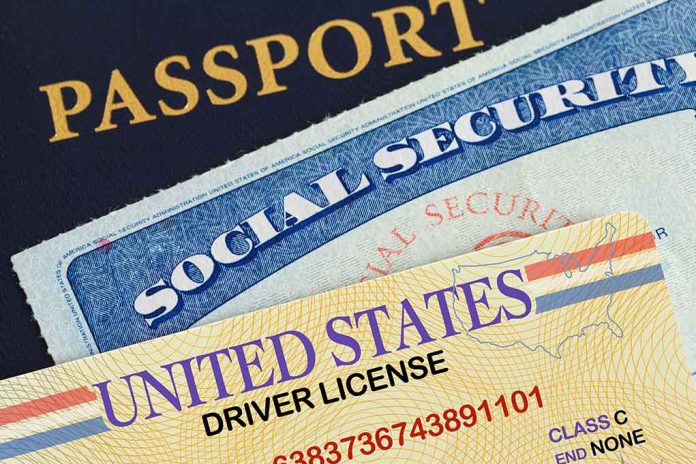
With the May 7, 2025, deadline for Real ID compliance fast approaching, millions of Americans remain unprepared for travel changes that could leave them stranded at airport security checkpoints.
Top Takeaways
- Starting May 7, 2025, all US adults will need a Real ID or alternative acceptable identification (passport, military ID) to board domestic flights or enter federal facilities.
- Currently, only about 61.2% of Americans have IDs that meet Real ID standards, leaving millions potentially facing travel disruptions.
- The Real ID requirement stems from post-9/11 security measures enacted by Congress in 2005 to enhance identification security and reduce counterfeiting.
- To obtain a Real ID, individuals must visit their DMV with specific documentation including proof of identity, Social Security number, and state residency.
- Many DMVs are experiencing increased demand, with some areas reporting appointment scalping as the deadline approaches.
Understanding the Real ID Requirement
The Real ID Act, passed by Congress in 2005 following recommendations from the 9/11 Commission, established new security standards for state-issued driver’s licenses and identification cards. These enhanced IDs are designed with specific security features to reduce counterfeiting and fraud. Real IDs can be identified by a star in the top right corner, while Enhanced Driver’s Licenses and IDs available in certain states have an American flag and the word “Enhanced.” Despite the approaching deadline, TSA reports that only about 81% of travelers currently present compliant identification at security checkpoints.
What You Need to Know Before the Deadline
The May 7, 2025, deadline affects all Americans aged 18 and older who plan to fly domestically or access certain federal facilities, including military bases and nuclear power plants. It’s important to note that Real ID is not required for driving, voting, applying for federal benefits, entering public buildings like post offices, or for children under 18 traveling with adults. Alternative forms of acceptable identification include valid US passports, passport cards, military IDs, and certain trusted traveler cards like Global Entry. These alternatives will continue to be accepted after the deadline.
While enforcement will be phased in, TSA spokesperson Patricia Mancha has warned that travelers without proper identification may experience delays. The enforcement approach is designed to reduce immediate disruption but will eventually result in denied access for those without compliant identification. This could potentially affect millions of Americans, as current compliance rates indicate nearly 40% of IDs in circulation don’t meet the standard despite multiple deadline extensions since the law was passed.
How to Obtain Your Real ID
Obtaining a Real ID requires an in-person visit to your state’s DMV or licensing agency with specific documentation. Required documents include proof of identity (such as a birth certificate or passport), proof of Social Security number (Social Security card or W-2), proof of date of birth, and two documents showing state residency (utility bills, bank statements). The exact requirements can vary slightly by state, so checking your state DMV website before your appointment is advisable.
Increasing Demand and State Responses
As the deadline approaches, many states are reporting increased demand at DMVs. Illinois has opened a Real ID supercenter specifically to process applications more efficiently, while other states are extending hours and adding staff. In Miami-Dade County, demand has grown so intense that reports indicate scalpers are selling DMV appointments, a practice one resident, Lizzie Colindres, called “not a good idea at all.” New York has also expanded opportunities for residents to obtain Real IDs as the deadline nears, offering more appointment options and streamlined processes.
Planning Ahead to Avoid Disruptions
With less than a year remaining before the deadline, experts recommend not waiting until the last minute to update your identification. DMVs nationwide are expected to face increasing demand in the coming months, potentially resulting in longer wait times for appointments and processing. For those who travel frequently, obtaining a passport may provide an additional layer of security as an acceptable alternative to a Real ID. Regardless of which option you choose, ensuring compliance well before the May 7, 2025, deadline is the best way to avoid potential travel disruptions.
Sources:
- Millions of Americans still don’t have a Real ID. Here’s what to know as the deadline nears
- REAL ID’s quickly approaching deadline has US citizens scrambling
- Millions Of Americans Remain Without ‘Real ID’ As May 7 Deadline Approaches







